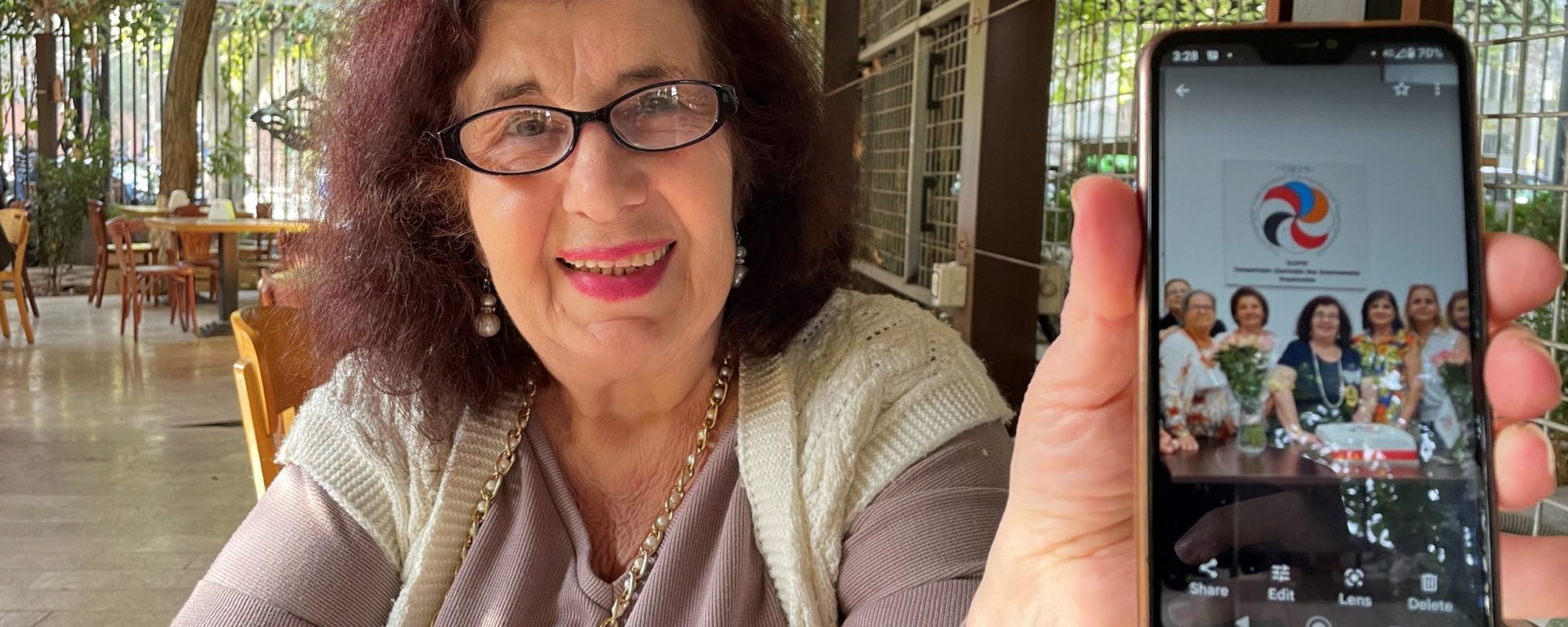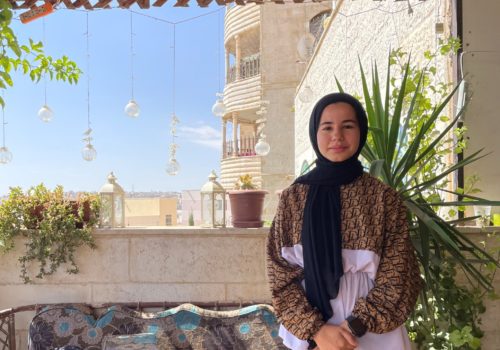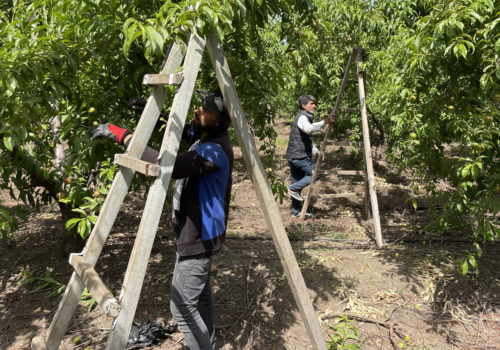YEREVAN, Armenia — On a crisp autumn day at a leafy café in this capital city, a bubbly middle-aged woman, Kohar Markeian, explained how conflict has followed her her entire life. She began to jot down dates on my notepad, squinting through her thick glasses to make sure each year was accurate.
In 1957, the year after her birth, an anti-Armenian mob marched through her native Aleppo in northern Syria shouting: “Put the poor Armenian under the knife!” Her family left town until tensions calmed. Then she watched her country confront Israel in wars in 1967 and again in 1973. In 1991, while she was living in Kuwait with her husband, the Iraqi dictator Saddam Hussein invaded the country, displacing the Markeian family back to Aleppo, where she remained until fighting engulfed Syria in 2011. That’s when she chose to return to her ancestral land of Armenia.
Markeian is one of 24,000 ethnic Armenian Syrian nationals who were offered citizenship to entice them to repatriate over the last decade to the former Soviet republic nestled in the South Caucasus mountains. Over a fifth of Armenians in Syria—once the largest such diaspora community in the Middle East—heeded the call to return to the collective homeland.
Violence first brought them to Syria. Most modern-day Syrian Armenians are descendants of those who were deported or escaped destruction during the Armenian genocide starting in 1915 and given refuge in Syria. More than a million Armenians were killed in the Ottoman Empire during death marches to the Syrian Desert. A hundred years later, the community was uprooted again.
Since relocating, Markeian has witnessed two wars in Armenia that were part of its border conflict with neighbor Azerbaijan (the war in the exclave Nagorno Karabakh in 2020 and subsequent hostilities this fall). But she’s done running. “I like my homeland,” she said. “All Armenians are welcome here.”
The migration of Syrian Armenians represents a small but important story in the reception of Syrians, the world’s largest refugee crisis of our time. The Armenian government is partial to its ethnic kin, encouraging Syrian Armenians to resettle as repatriates, not refugees, which has made the country the third largest per-capita host of Syrians in Europe. Unlike many other host countries, Armenians—including the government and society in general—have fully embraced their arrival.
But although they have integrated largely successfully, most of the new arrivals don’t want to assimilate, with its implication of losing one’s previous identity. Armenians in Syria had earlier found a way to hold on to their language and customs; now they’re preserving their Syrian community within Armenia. Despite many favorable conditions for resettling, they still feel like exiles, a sentiment recently exacerbated by an influx of tens of thousands of Russians and Ukrainians escaping the Kremlin’s war on Ukraine who have heightened social differences and created economic pressures for Syrian Armenians still adapting to their new home.
* * *
On Pushkin Street in Yerevan’s city center, one can easily see the influence Syrian Armenians—many of them business owners and artisans—have had on the city over the last decade. The names of many restaurants and shops start with Abou, “father” in Arabic, or end with the suffix ian, denoting the last name of western Armenians. There is the Aleppo Market, a warren of shops where Arabic signs offer services for hair salons, food, tourism and more. Tiny icons of venerated Levantine-born saints stand in store windows. Turn the corner onto the once largely vacant Martiros Saryan Street, named after the great Armenian painter that used even more color than Henri Matisse, and a string of pleasant wine bars now line the road, many of which opened with the capital and entrepreneurial spirt of these Syrian Armenian newcomers.
William Faulkner wrote: “The past is never dead. It’s not even past.” The Syrian Armenians who relocated to Armenia as a result of the Syrian civil war see their return as their second displacement after being driven out during the Armenian genocide a century earlier.
Beginning in 1915, on the order of Talaat Pasha, part of a triumvirate of the Young Turks, who seized power in a coup d’état and led the crumbing Ottoman Empire, more than a million Armenians were sent on death marches to the Syrian Desert. It was World War I, and the Ottomans had allied with the Germans. Armenians and other religious minorities in the Ottoman Empire were blamed for conspiring with Allied Powers to threaten the once-great power.
Around the same time, the first Armenian state since the Middle Ages formed in a southern corner of the disintegrating Russian Empire. The new republic was a small sliver on the eastern edge of the historic Armenian Empire, the first state to have adopted Christianity as its official religion in the fourth century, that once stretched from the Caspian Sea to the Mediterranean. Three years later, it became part of the Soviet Union, and the most ethnically homogenous of the socialist republics.
Armenian survivors of the genocide were dispersed to concentration camps or relocated to Aleppo from the desert, which became the center of the emerging Armenian diaspora in Syria. While Aleppo had the largest Armenian presence, vibrant communities also formed across Syrian cities in Damascus, Qamishli, Homs and elsewhere. They were called “New Armenians” in Syria, mixed with “Old Armenians” who had been living in Syrian cities and towns since antiquity. In time, linguistic and geographical differences arose between western Armenians living in the Middle East and the Sovietized eastern Armenians.
Concerted efforts throughout the 20th century encouraged Syrian Armenians to repatriate to Soviet Armenia. After millions of Soviet soldiers died in World War II, the dictator Josef Stalin pushed for what was coined the Great Repatriation, in which Armenians in Syria, Lebanon, Iraq and elsewhere were offered homes, jobs and citizenship to relocate to their motherland in Armenia. In 1946, as French colonizers were packing up and leaving Syria, nearly 40,000 Armenians from the Levant region moved. One of them, Levon Ter-Petrosyan, emigrated from Aleppo, later to become the first Armenian president after the fall of the Soviet Union.
A decade later, another collective expatriation occurred when Syria and Egypt formed the United Arab Republic in the late 1950s. The pan-Arab, socialist plan of Egyptian president Gamal Abdel Nasser to establish a political union between Egypt and Syria placed restrictions on the Syrian Armenian community’s freedoms and finances in Syria so they started anew in Armenia.
The majority of Syrian Armenians, however, remained in Aleppo, Damascus and other cities, where they built communities that became the standard bearers of the Armenian exile.
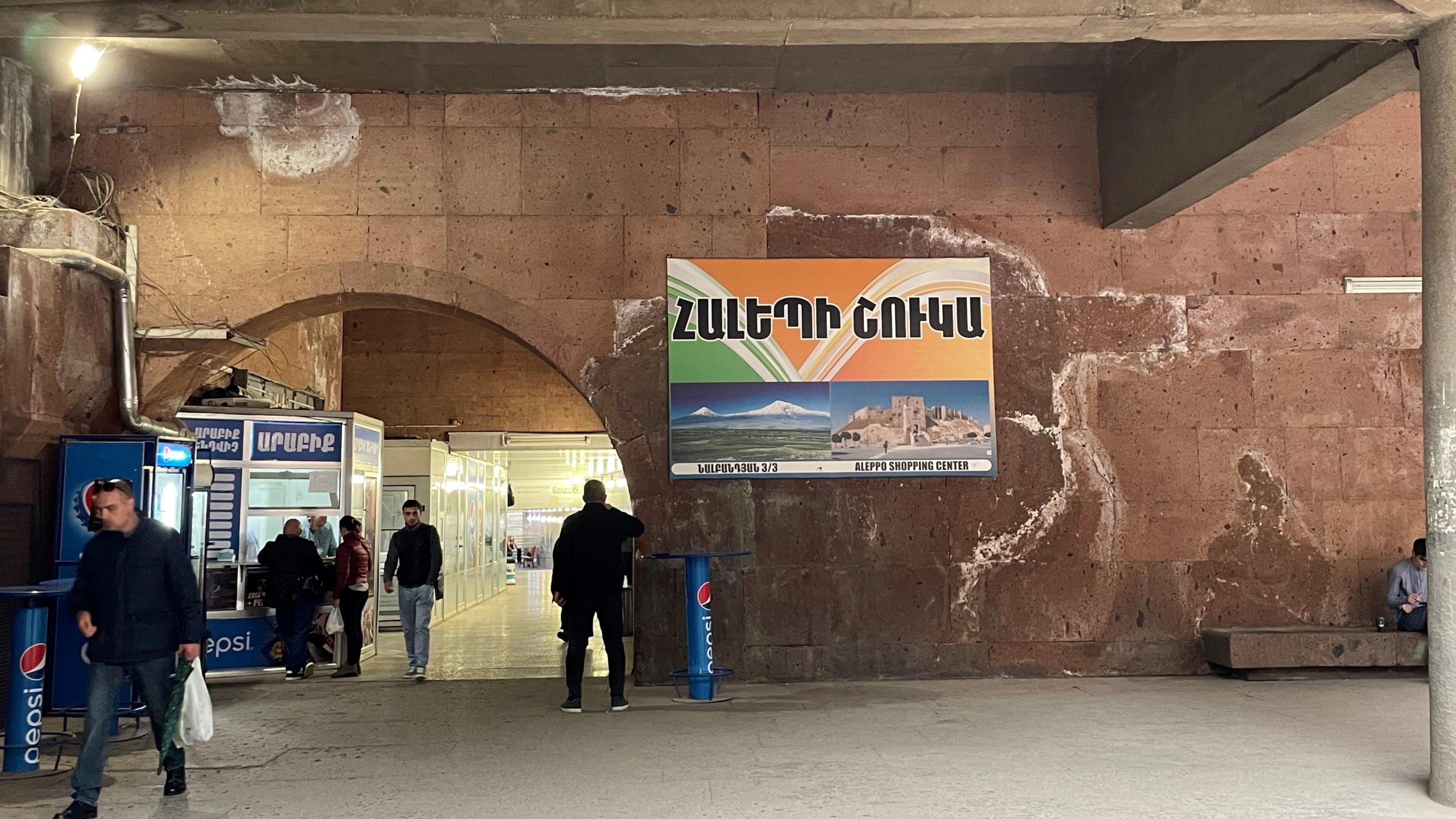
As a Christian minority, Armenians had been subject to religious persecution and wanted to protect themselves. When Hafez al-Assad, father of the current Syrian president, took power after a military coup in 1963, he secured the Armenian community’s political loyalty in exchange for cultural and religious autonomy. They were able to operate their own churches, schools in their local dialect known as western Armenian, newspapers, scout troops and more. They also deepened their connections with Soviet Armenia, traveling for education and tourism.
Among Syrian Armenians emigrating to Armenia prior to the Syrian civil war, Hagop Kazanjian moved from Aleppo to Yerevan in 2006 to attend university, following his parents who had studied there in the early 1970s. Fresh-faced with well-coiffed black hair, he explained to me over grilled meat in a basement tavern how he had already decided to stay in Armenia even before having traveled there. “That is how connected my family is to here,” he said. “I came assimilated on arrival” There was no sizable community in Yerevan at that time, he added, so Syrian Armenians quickly picked up the eastern Armenian dialect.
Kazanjian considers himself native in both eastern and western dialects, which both have the same roots in Armenian Christian liturgy but grew apart in grammar and pronunciation due to 20th-century geographic divisions. He started a wine company Galar Vines, which means “winding,” a reference to the unforeseen twists and turns that led him to winemaking in Armenia.
* * *
Unlike those who moved to Armenia before 2011, the rapid influx of Syrian Armenians into Yerevan created a community within a community. Power in numbers meant that their own network and connections from back in Syria remained strong, shielding them from the need to fully assimilate.
Not surprisingly, many Syrian Armenians didn’t encounter what they had expected on arriving in Armenia, describing it as an estranged post-Soviet country in transition rather than anything feeling like a native land. Hovsep Krikorian, a quirky, bookish medical student who is now completing his degree in Yerevan, described first visiting Armenia during a high school competition in 2010. “No one would smile. Like no one,” he said, leaning forward in the quiet café where we met to emphasize how big the contrast between the warm Syrian greetings to which he was used to and the steely reception he actually got from locals.
“When we were at the airport to fly back to Aleppo,” he said, “I told one of my teammates, ‘I would never live here.’”
At the outbreak of the Syrian war in 2011, Syrian Armenians were initially spared from violence. But like all other segments of society, eventually they could not escape the bloodshed.
In 2014, militants blew up the Armenian Genocide Memorial Chapel in Deir ezZor, in eastern Syria, which housed the remains of Armenians sent on the 1915-1916 death marches into the desert. Turkish forces later occupied large swaths of northern Syria, and Syrian Armenians saw haunting parallels with what happened to their ancestors a century earlier. “It was the continuation of the genocide,” Kazanjian, the winemaker, said.
Just under half the 60,000 ethnic Armenians who have left Syria over the last decade moved to Armenia, where they were offered the options of citizenship, residency or asylum status. (Young men wishing to avoid Armenia’s mandatory military service tended to opt for long-term residency; others requested asylum in hope of being resettled in a third country.)
The United Nations Refugee Agency in Armenia is working to incorporate them into society, according to external relations associate Anahit Hayrapetyan. “It’s the main durable solution instead of resettlement or return,” she told me.
* * *
Even before the Armenian Republic restored its independence from Moscow in 1991, the country saw inflows of ethnic Armenians from the diaspora fleeing from instability elsewhere, providing lessons for the current integration of Syrian Armenians.
In 1980, hundreds of thousands of ethnic Armenians escaping violence in neighboring Azerbaijan were accommodated in crudely built social housing that has since turned into isolated ghettos. The state has been dealing with the challenges that came with communal housing for these transplants for the past 40 years, Armen Ghazaryan, the head of Armenia’s Migration Service, told me.
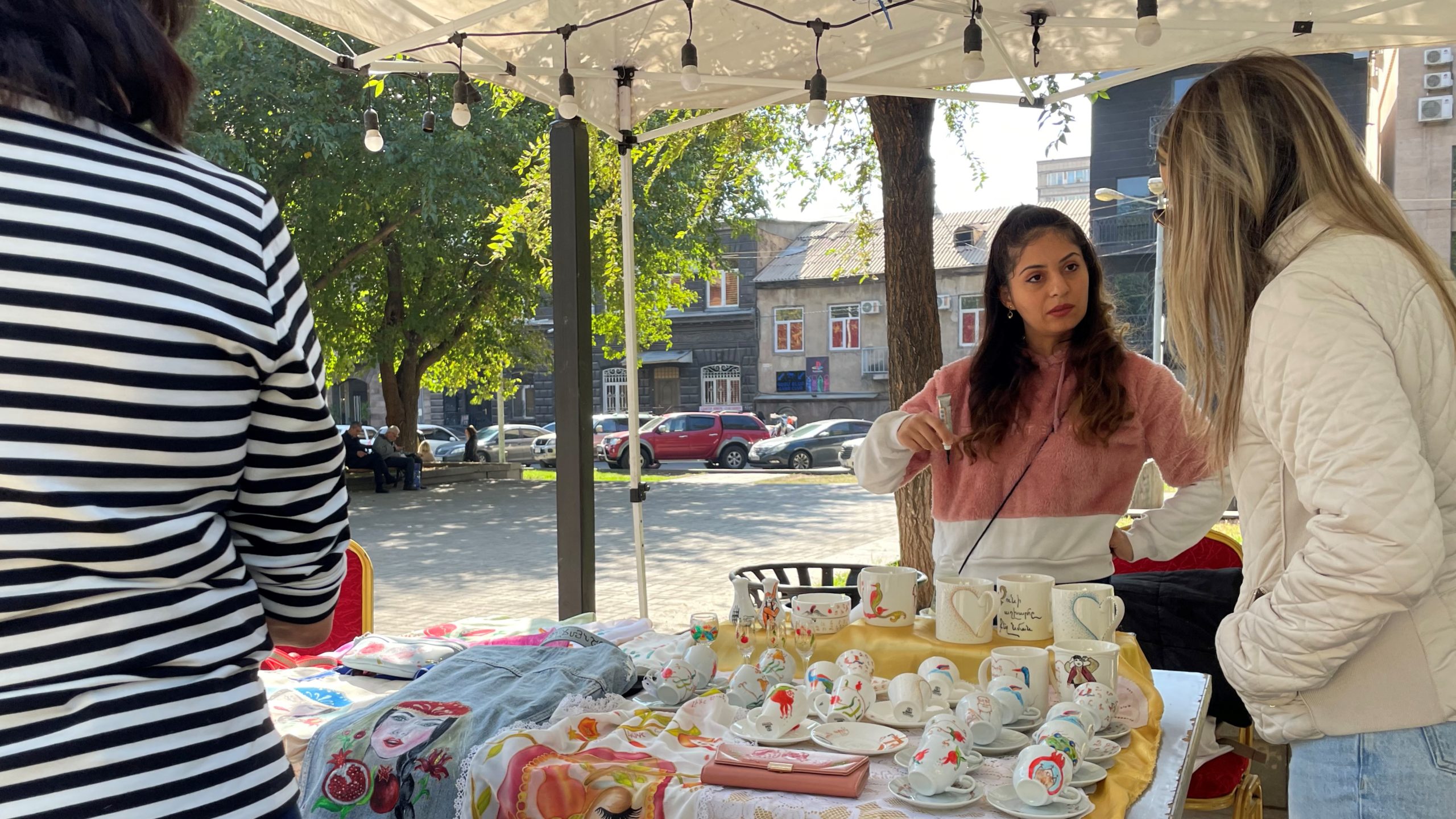
In Yerevan, where the majority of Syrian Armenians have settled, the Armenian government and private donors decided to offer rental subsidies instead. “We learned not to put vulnerable, poor people all in one place,” Ghazaryan said. Utility and medical costs were also subsidized by the state and charities. Schools offered additional instruction to help new students catch up. The government wanted these newcomers to be brought into the fold as quickly as possible.
Markeian, the formerly itinerant Syrian Armenian who is determined to make a permanent home in Yerevan, says that the warm reception has made a world of difference. “I remember seeing pictures of Mashtots Avenue in my schoolbooks as a little girl back in Aleppo,” Markeian said, referring to the commercial thoroughfare we looked out on in central Yerevan. “And now I am finally here,” she said beaming. On top of the positive response, Markeian appreciates the small social security check she receives each month as an Armenian citizen. “They try their best to take care of you here,” she said.
* * *
Everyone in Yerevan first comments on Syrian Armenians’ contribution to the long-stagnant culinary scene. Over the past decade, many Syrian-Armenian restaurants have opened, drastically changing a local food scene long dominated by only dill, cilantro and bad service.
A three-generation bakery named Lahmacun Gaidz that relocated from Aleppo to Yerevan has an especially warm atmosphere. It specializes in lahmacun, a flatbread spread with spiced meat and accompanied by lemon, parsley and spicy Aleppo pepper. Inside, Salpi Jabakhtchurian runs the front of house. In a bright red sweater and an even brighter smile, she joked, “Look, they had lahmacun before we came here, but that wasn’t lahmacun.”
Her grandmother taught her the family recipe. “It contains the right mix of spices, which is a secret so don’t even think of asking,” she said, stepping away to help a first-time visitor properly roll his hubcap-sized pie before returning to explain how much more the restaurant benefits from tourists here than her shop did back in Syria. “I love it though,” she said. “I get to open up my home to the whole world.”
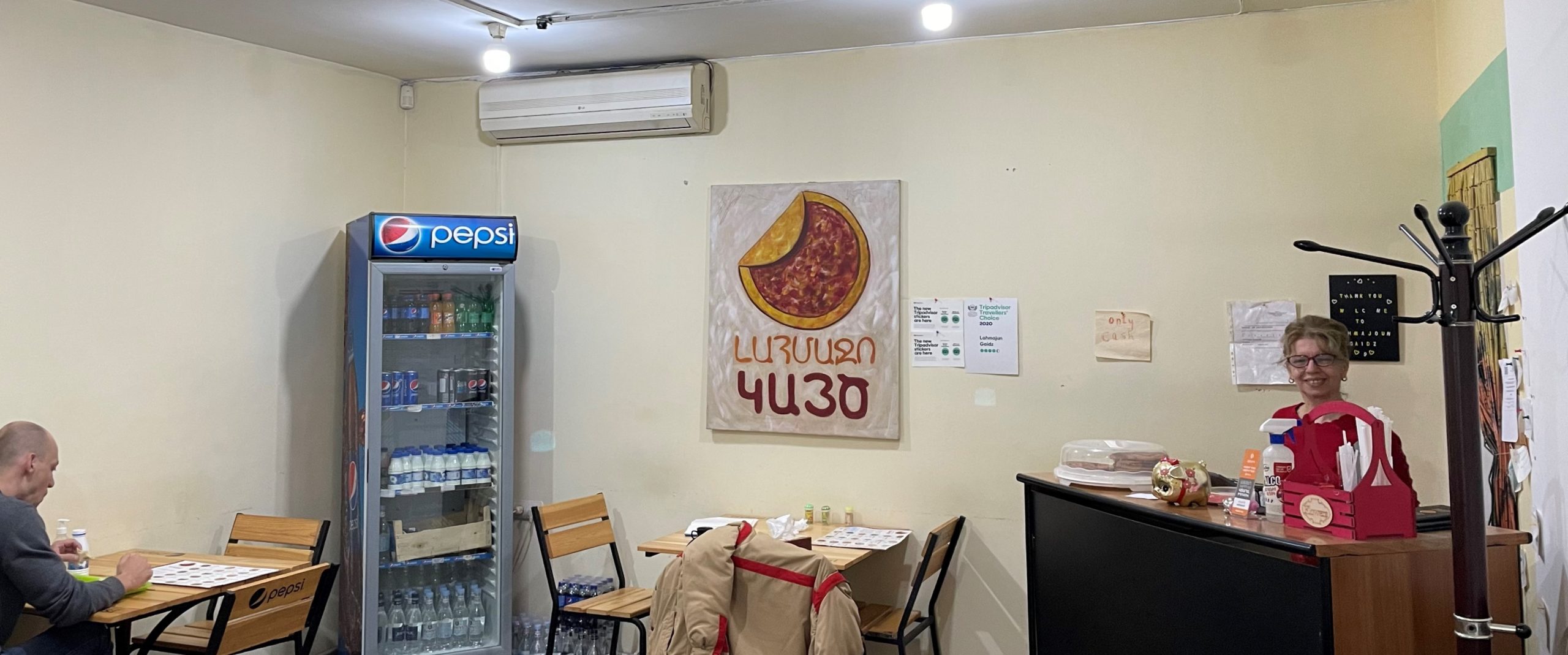
Syrian Armenians are also known for their handiwork. Thousands of new jewelers, tailors, photographers, shoemakers and mechanics have now joined the Yerevan market economy, improving the overall quality of products in the domestic market, according to many residents of the city. All the more important now that many of Armenia’s major neighboring markets are dealing with their own instability. “We brought more than just falafel,” a lecturer at the American University of Armenia originally from Damascus said wryly. He asked to withhold his name.
Life is improving and the city is developing. In 2018, a group of Syrian Armenians successfully advocated to transform a derelict Soviet-era building into a commercial hub called the Syrian Armenian Industrial Zone. A mélange of 19 different workshops buzzes with everything from a laser cutter to a piano repair shop. A 3-D printer hums all evening, producing a mold for drone prototypes.
In one workspace, a burly businessman from Aleppo leaned over a table, tinkering with car engine starters and other spare parts. He shares a wall with a music studio, where a rock and roll band is loudly practicing. “I request songs from time to time,” Hrach Yapoujian joked.
He is thankful for the factory, with its fully functioning utilities. “I am looking to grow but I need to recreate my customer base.,” he said, explaining that pre-war Aleppo’s population was double the size of that of Yerevan. “The orders are much smaller here.”
An auto repair mechanic named Hovsep Ayranjian has also struggled working in an unfamiliar market. “Back in Aleppo, my father had a great reputation and customers trusted whatever he said needed to be done,” he said. Ayranjian has had to learn to fix different types of cars than were common in Syria. Moreover, Russian, not Arabic, is the lingua franca for sourcing car parts. He’s also unable to apply for affordable loans to update his equipment, with no assets to offer as collateral.
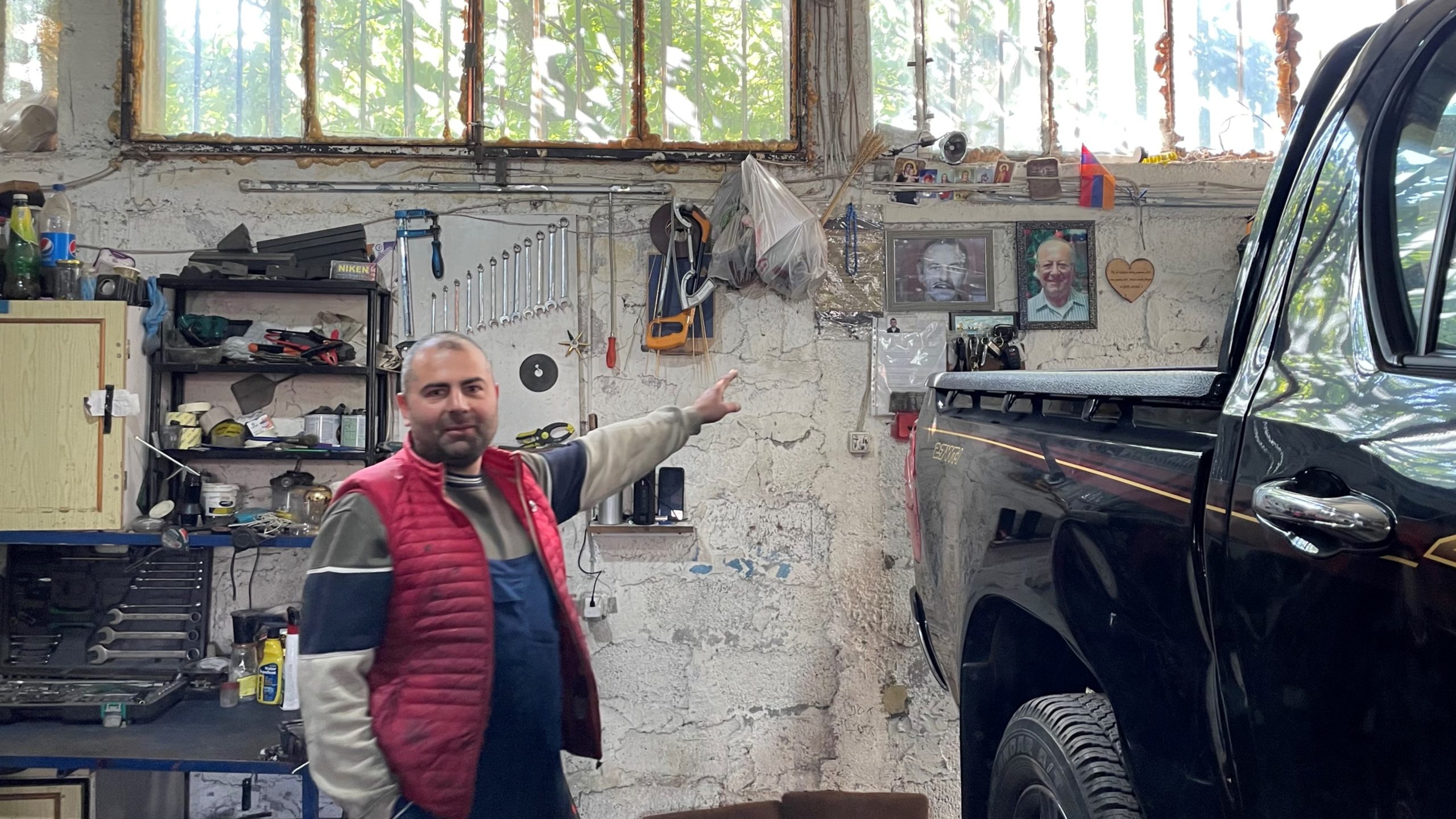
“We owned our shop back in Syria, but we have to rent everything here, and prices are going up,” he said. “I learned the trade under my father, but my son has no reason to learn. There is nothing for me to leave him.”
Ayranjian’s struggles are not uncommon. Despite the Armenian government’s prioritizing of economic integration, approximately half of the Syrian Armenians who came to Armenia since 2011 have had to move on to seek work abroad after failing to secure a livelihood in the country. Syrian Armenians joined in what has been a long exodus by Armenians in search of work; one local summed it up with a common saying: “Where there is bread, there is my country.”
* * *
Although many I spoke to appreciate their reception here in an Armenian nation, a decade on, they are still not fully at home in a country that differs linguistically and culturally from their own roots.
It is easier to get by in Yerevan in Russian than in western Armenian. “As soon as you arrive in the airport, you realize something is wrong,” the university lecturer said. “No one understands you and this is not the country you learned about.” Health care here is dominated by the Russian language. Syrian Armenians can’t communicate or fully understand their doctors unless they pay more at the few clinics with Arabic or English-speaking physicians.
Some new arrivals fear an expectation of total assimilation. In Syria, ethnic Armenians prioritized linguistic and cultural self-preservation over totally blending in. Now, even in what’s supposed to be their new home, they want to find a way to hold on to their own heritage.
“You get over the excitement of seeing signs written in Armenian, and you start seeing the problems that you don’t fully belong,” he said. Currently working on his dissertation, he senses discrimination when he speaks in his native western Armenian. He advocates for the government to officially recognize western Armenian.
Other Syrian Armenians are finding creative ways to promote the preservation of western Armenian and its contribution to the Armenian Republic. Sevan Keleshian produces and stars in a popular local travel program called “What Will I Say, What Will You Say?” on a local public television station that shows Armenians from different regions can learn to understand each other’s dialects with time.
Keleshian and I spoke in a minimalist café with monochromatic walls and Russian men huddled over silver MacBooks. “No one will understand you. You should just change,” she recalled being told when she first moved to Yerevan from Aleppo. “But if I change the way I speak, I will change who I am,” she added.
This past season, she travelled to Lori, a region in northern Armenia known for its eccentric customs and elongated vowels, to film everyday interactions with villagers. The whimsical show has been well-received and, according to Keleshian, hammers home an important point: “The different dialects in greater Armenia are a strength not a weakness.”
* * *
In 2020, Armenia’s neighbor Azerbaijan, backed by Turkey, retook large portions of Nagorno-Karabakh and nearby territories, forcing 30,000 Armenians to flee to Yerevan and other parts of the country. Thus a long-frozen conflict heated up again.
Some Syrian Armenians had been enlisted in the Armenian army, although most had opted for long-term residency precisely to avoid conscription. Others felt renewed trauma amid looming conflict, and temporarily returned to Syria, seeing it as a safer option.
A Syrian Armenian named Mirna Bzdigian felt she was able to help a grieving society. She became Miss Armenia in 2021, the first ever born in Syria. “As someone who survived the Syrian war, I wanted Armenians not to lose hope,” she said. “Better days are to come.”
Bzdigian travelled around the country meeting victims of the war and raising awareness and funds for prosthetic surgeries. As a contestant in the Miss World pageant in Puerto Rico in 2022, she also highlighted their stories on an international stage, speaking about what Armenians were going through and what still needed to be done for the casualties. “We got lots of comments for our plight and people expressed their support,” she said.

When Russian President Vladimir Putin invaded Ukraine this past February, displaced Syrian Armenians again became caught up in the net of international conflict. Tens of thousands of Russians relocated to Yerevan, which led to the doubling and later tripling of house prices.
Over 80 percent of Syrian émigrés in Yerevan do not own their homes, according to Aleppo NGO, a non-profit set up for the Syrian Armenian community. Many Armenian landlords have given Syrian-Armenian renters a tough deal: either pay up or leave by the end of the month.
Hovsep Ayranjian, the mechanic, described having spent much of a year fixing up and furnishing an apartment for his family only for his landlord to tell him he had to leave. “I still had another year on my lease, but it didn’t matter,” he said, adding that he believed the landlord was clearing space to rent to Russians.
With few military-age Russian men likely to return home any time soon, some Syrian Armenians are desperately seeking to sell off devalued property back in Syria at any price to cover rising rents.
Syrian Armenians are especially disadvantaged relative to the rest of society because nearly all Armenians inherited their homes after the fall of the Soviet Union, providing basic financial security and access to credit. With weak rule of law and limited experience in social organizing among Syrian Armenians, the divide will likely only deepen. Even as citizens, many still feel like refugees.
“Back home I was seen as Armenian,” one renter, Ramzig, said. “Here I am seen as a Syrian, only a visitor.”
* * *
The Syrian village of Kessab on the slope of Mount Aqraa, near Turkey, has always been predominantly Armenian. Syrian Armenian youth scouts from other parts of the country would come there each summer to camp, play sports and sing Armenian folk songs. A denizen of Kessab, a historian and ethnographer named Hagop Tcholakian characterizes himself as an old Armenian, tracing his lineage to the village since the Seleucid Period before Christ.
In March 2014, a multi-pronged attack of extremist militant groups displaced nearly 1,000 residents. Because of the village’s importance to the Syrian Armenian community, it was a major psychological blow. Tcholakian, a university professor, was an eyewitness to the attack and published a book about it called “The Three Days of Kessab.”
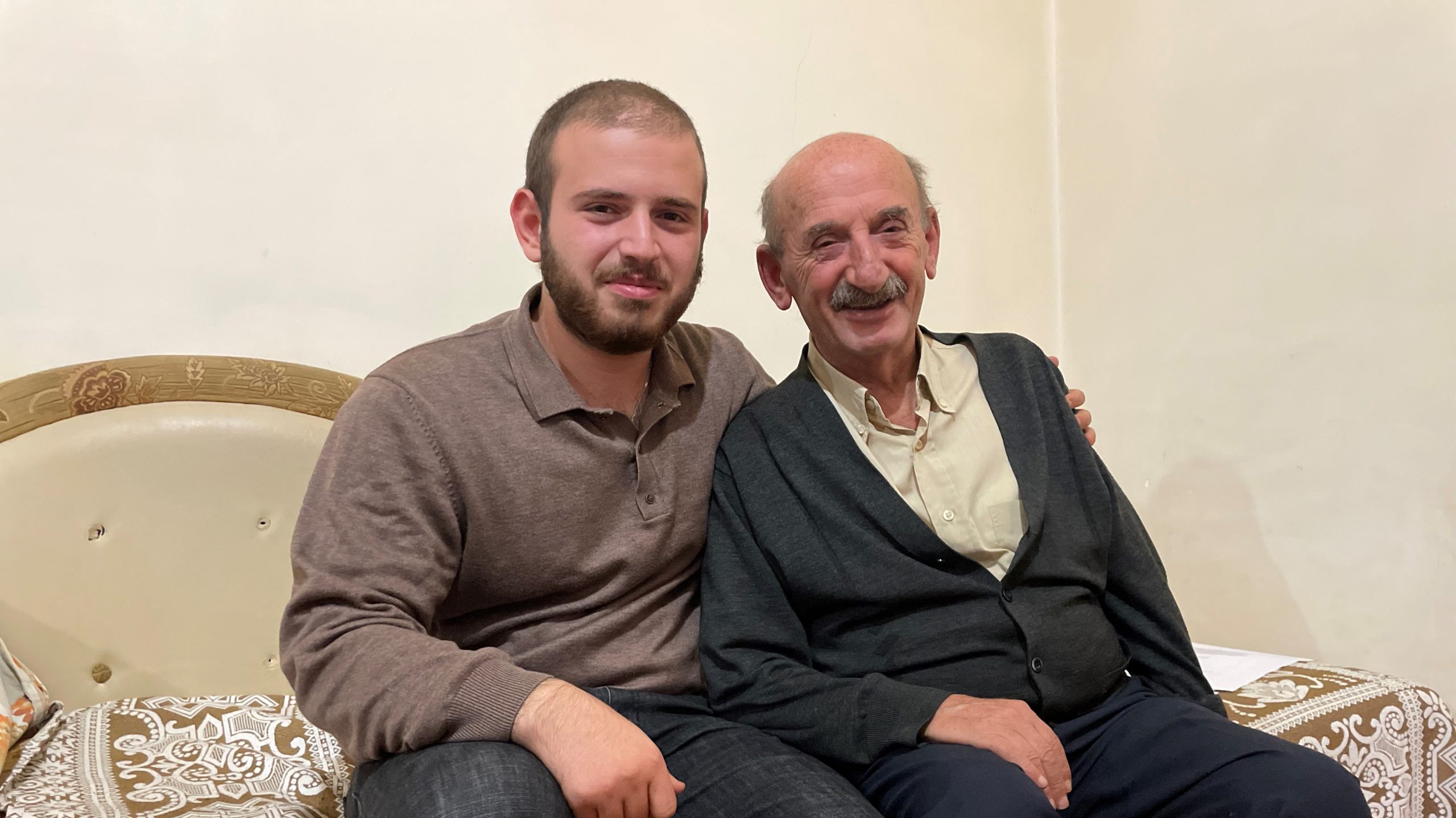
He soon relocated with his family to Yerevan where he has been ever since, now part of the faculty at Yerevan State University. I met him and his family at their new faculty housing. Ageing yet effervescent, Tcholakian told me about his first trip back to Kessab where he and other elders reminisced about the old days in school, church and the scouts. “Its nice here [in Yerevan], but that longing for Syria is with all of us no matter where we might now live.”
His son, also named Hagop, is looking to a future in Armenia, however. Now studying law at university in Yerevan, he aimed to secure his family’s prospects in Yerevan. Hagop opted to stay behind in Armenia to complete an internship in a law firm while his father went to visit Syria.
He was disappointed to see their home in Kessab alone, but didn’t blame his son, saying there was nothing to return to in the village. “Why would anyone young today ever want to go back? I might be Syrian Armenian, but he is now Armenian Armenian.”
Top photo: After a lifetime of running from conflicts, Kohar Markeian is determined to make a home in Yerevan. She gives back by facilitating regular meetings with displaced Syrian Armenians to build a support network

